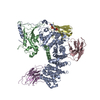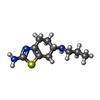+ Open data
Open data
- Basic information
Basic information
| Entry | Database: EMDB / ID: EMD-30410 | |||||||||
|---|---|---|---|---|---|---|---|---|---|---|
| Title | Dopamine Receptor D3R-Gi-Pramipexole complex | |||||||||
 Map data Map data | ||||||||||
 Sample Sample |
| |||||||||
 Keywords Keywords | G protein-coupled receptor / Dopamine receptor / MEMBRANE PROTEIN | |||||||||
| Function / homology |  Function and homology information Function and homology informationmusculoskeletal movement, spinal reflex action / acid secretion / dopamine neurotransmitter receptor activity, coupled via Gi/Go / response to histamine / adenylate cyclase-inhibiting dopamine receptor signaling pathway / regulation of potassium ion transport / Dopamine receptors / regulation of dopamine uptake involved in synaptic transmission / positive regulation of dopamine receptor signaling pathway / phospholipase C-activating dopamine receptor signaling pathway ...musculoskeletal movement, spinal reflex action / acid secretion / dopamine neurotransmitter receptor activity, coupled via Gi/Go / response to histamine / adenylate cyclase-inhibiting dopamine receptor signaling pathway / regulation of potassium ion transport / Dopamine receptors / regulation of dopamine uptake involved in synaptic transmission / positive regulation of dopamine receptor signaling pathway / phospholipase C-activating dopamine receptor signaling pathway / negative regulation of oligodendrocyte differentiation / G protein-coupled receptor internalization / negative regulation of synaptic transmission, glutamatergic / arachidonate secretion / response to morphine / negative regulation of cytosolic calcium ion concentration / positive regulation of cytokinesis / dopamine metabolic process / regulation of dopamine secretion / social behavior / negative regulation of protein secretion / prepulse inhibition / adenylate cyclase inhibitor activity / negative regulation of blood pressure / positive regulation of protein localization to cell cortex / behavioral response to cocaine / T cell migration / Adenylate cyclase inhibitory pathway / D2 dopamine receptor binding / response to prostaglandin E / adenylate cyclase regulator activity / G protein-coupled serotonin receptor binding / adenylate cyclase-inhibiting serotonin receptor signaling pathway / positive regulation of mitotic nuclear division / negative regulation of phosphatidylinositol 3-kinase/protein kinase B signal transduction / cellular response to forskolin / regulation of mitotic spindle organization / learning / response to cocaine / circadian regulation of gene expression / Regulation of insulin secretion / locomotory behavior / positive regulation of cholesterol biosynthetic process / electron transport chain / negative regulation of insulin secretion / G protein-coupled receptor binding / response to peptide hormone / G protein-coupled receptor activity / visual learning / adenylate cyclase-inhibiting G protein-coupled receptor signaling pathway / adenylate cyclase-modulating G protein-coupled receptor signaling pathway / centriolar satellite / G-protein beta/gamma-subunit complex binding / Olfactory Signaling Pathway / Activation of the phototransduction cascade / intracellular calcium ion homeostasis / G beta:gamma signalling through PLC beta / Presynaptic function of Kainate receptors / Thromboxane signalling through TP receptor / G protein-coupled acetylcholine receptor signaling pathway / Activation of G protein gated Potassium channels / Inhibition of voltage gated Ca2+ channels via Gbeta/gamma subunits / G-protein activation / G beta:gamma signalling through CDC42 / Prostacyclin signalling through prostacyclin receptor / Glucagon signaling in metabolic regulation / G beta:gamma signalling through BTK / Synthesis, secretion, and inactivation of Glucagon-like Peptide-1 (GLP-1) / ADP signalling through P2Y purinoceptor 12 / photoreceptor disc membrane / Sensory perception of sweet, bitter, and umami (glutamate) taste / Glucagon-type ligand receptors / Adrenaline,noradrenaline inhibits insulin secretion / GDP binding / Vasopressin regulates renal water homeostasis via Aquaporins / Glucagon-like Peptide-1 (GLP1) regulates insulin secretion / G alpha (z) signalling events / ADP signalling through P2Y purinoceptor 1 / cellular response to catecholamine stimulus / ADORA2B mediated anti-inflammatory cytokines production / G beta:gamma signalling through PI3Kgamma / adenylate cyclase-activating dopamine receptor signaling pathway / Cooperation of PDCL (PhLP1) and TRiC/CCT in G-protein beta folding / GPER1 signaling / G-protein beta-subunit binding / cellular response to prostaglandin E stimulus / heterotrimeric G-protein complex / Inactivation, recovery and regulation of the phototransduction cascade / G alpha (12/13) signalling events / extracellular vesicle / sensory perception of taste / Thrombin signalling through proteinase activated receptors (PARs) / signaling receptor complex adaptor activity / G protein activity / retina development in camera-type eye / GTPase binding / Ca2+ pathway / fibroblast proliferation / midbody / cell cortex Similarity search - Function | |||||||||
| Biological species |  Homo sapiens (human) / Homo sapiens (human) /   | |||||||||
| Method | single particle reconstruction / cryo EM / Resolution: 3.0 Å | |||||||||
 Authors Authors | Xu P / Huang S | |||||||||
| Funding support |  China, 1 items China, 1 items
| |||||||||
 Citation Citation |  Journal: Mol Cell / Year: 2021 Journal: Mol Cell / Year: 2021Title: Structures of the human dopamine D3 receptor-G complexes. Authors: Peiyu Xu / Sijie Huang / Chunyou Mao / Brian E Krumm / X Edward Zhou / Yangxia Tan / Xi-Ping Huang / Yongfeng Liu / Dan-Dan Shen / Yi Jiang / Xuekui Yu / Hualiang Jiang / Karsten Melcher / ...Authors: Peiyu Xu / Sijie Huang / Chunyou Mao / Brian E Krumm / X Edward Zhou / Yangxia Tan / Xi-Ping Huang / Yongfeng Liu / Dan-Dan Shen / Yi Jiang / Xuekui Yu / Hualiang Jiang / Karsten Melcher / Bryan L Roth / Xi Cheng / Yan Zhang / H Eric Xu /   Abstract: The dopamine system, including five dopamine receptors (D1R-D5R), plays essential roles in the central nervous system (CNS), and ligands that activate dopamine receptors have been used to treat many ...The dopamine system, including five dopamine receptors (D1R-D5R), plays essential roles in the central nervous system (CNS), and ligands that activate dopamine receptors have been used to treat many neuropsychiatric disorders. Here, we report two cryo-EM structures of human D3R in complex with an inhibitory G protein and bound to the D3R-selective agonists PD128907 and pramipexole, the latter of which is used to treat patients with Parkinson's disease. The structures reveal agonist binding modes distinct from the antagonist-bound D3R structure and conformational signatures for ligand-induced receptor activation. Mutagenesis and homology modeling illuminate determinants of ligand specificity across dopamine receptors and the mechanisms for G protein coupling. Collectively our work reveals the basis of agonist binding and ligand-induced receptor activation and provides structural templates for designing specific ligands to treat CNS diseases targeting the dopaminergic system. | |||||||||
| History |
|
- Structure visualization
Structure visualization
| Movie |
 Movie viewer Movie viewer |
|---|---|
| Structure viewer | EM map:  SurfView SurfView Molmil Molmil Jmol/JSmol Jmol/JSmol |
| Supplemental images |
- Downloads & links
Downloads & links
-EMDB archive
| Map data |  emd_30410.map.gz emd_30410.map.gz | 17.9 MB |  EMDB map data format EMDB map data format | |
|---|---|---|---|---|
| Header (meta data) |  emd-30410-v30.xml emd-30410-v30.xml emd-30410.xml emd-30410.xml | 17.6 KB 17.6 KB | Display Display |  EMDB header EMDB header |
| Images |  emd_30410.png emd_30410.png | 51.3 KB | ||
| Filedesc metadata |  emd-30410.cif.gz emd-30410.cif.gz | 6.5 KB | ||
| Archive directory |  http://ftp.pdbj.org/pub/emdb/structures/EMD-30410 http://ftp.pdbj.org/pub/emdb/structures/EMD-30410 ftp://ftp.pdbj.org/pub/emdb/structures/EMD-30410 ftp://ftp.pdbj.org/pub/emdb/structures/EMD-30410 | HTTPS FTP |
-Validation report
| Summary document |  emd_30410_validation.pdf.gz emd_30410_validation.pdf.gz | 435.7 KB | Display |  EMDB validaton report EMDB validaton report |
|---|---|---|---|---|
| Full document |  emd_30410_full_validation.pdf.gz emd_30410_full_validation.pdf.gz | 435.3 KB | Display | |
| Data in XML |  emd_30410_validation.xml.gz emd_30410_validation.xml.gz | 5.6 KB | Display | |
| Data in CIF |  emd_30410_validation.cif.gz emd_30410_validation.cif.gz | 6.4 KB | Display | |
| Arichive directory |  https://ftp.pdbj.org/pub/emdb/validation_reports/EMD-30410 https://ftp.pdbj.org/pub/emdb/validation_reports/EMD-30410 ftp://ftp.pdbj.org/pub/emdb/validation_reports/EMD-30410 ftp://ftp.pdbj.org/pub/emdb/validation_reports/EMD-30410 | HTTPS FTP |
-Related structure data
| Related structure data |  7cmuMC  7cmvC M: atomic model generated by this map C: citing same article ( |
|---|---|
| Similar structure data |
- Links
Links
| EMDB pages |  EMDB (EBI/PDBe) / EMDB (EBI/PDBe) /  EMDataResource EMDataResource |
|---|---|
| Related items in Molecule of the Month |
- Map
Map
| File |  Download / File: emd_30410.map.gz / Format: CCP4 / Size: 27 MB / Type: IMAGE STORED AS FLOATING POINT NUMBER (4 BYTES) Download / File: emd_30410.map.gz / Format: CCP4 / Size: 27 MB / Type: IMAGE STORED AS FLOATING POINT NUMBER (4 BYTES) | ||||||||||||||||||||||||||||||||||||||||||||||||||||||||||||||||||||
|---|---|---|---|---|---|---|---|---|---|---|---|---|---|---|---|---|---|---|---|---|---|---|---|---|---|---|---|---|---|---|---|---|---|---|---|---|---|---|---|---|---|---|---|---|---|---|---|---|---|---|---|---|---|---|---|---|---|---|---|---|---|---|---|---|---|---|---|---|---|
| Projections & slices | Image control
Images are generated by Spider. | ||||||||||||||||||||||||||||||||||||||||||||||||||||||||||||||||||||
| Voxel size | X=Y=Z: 1.014 Å | ||||||||||||||||||||||||||||||||||||||||||||||||||||||||||||||||||||
| Density |
| ||||||||||||||||||||||||||||||||||||||||||||||||||||||||||||||||||||
| Symmetry | Space group: 1 | ||||||||||||||||||||||||||||||||||||||||||||||||||||||||||||||||||||
| Details | EMDB XML:
CCP4 map header:
| ||||||||||||||||||||||||||||||||||||||||||||||||||||||||||||||||||||
-Supplemental data
- Sample components
Sample components
+Entire : Dopamine Receptor D3R-Gi-Pramipexole complex
+Supramolecule #1: Dopamine Receptor D3R-Gi-Pramipexole complex
+Supramolecule #2: Guanine nucleotide-binding protein
+Supramolecule #3: scfv16
+Supramolecule #4: chimera protein of Soluble cytochrome b562 and D(3) dopamine receptor
+Macromolecule #1: Guanine nucleotide-binding protein G(i) subunit alpha-1
+Macromolecule #2: Guanine nucleotide-binding protein G(I)/G(S)/G(T) subunit beta-1
+Macromolecule #3: Guanine nucleotide-binding protein G(I)/G(S)/G(O) subunit gamma-2
+Macromolecule #4: scfv16
+Macromolecule #5: Soluble cytochrome b562,D(3) dopamine receptor
+Macromolecule #6: (6S)-N6-propyl-4,5,6,7-tetrahydro-1,3-benzothiazole-2,6-diamine
-Experimental details
-Structure determination
| Method | cryo EM |
|---|---|
 Processing Processing | single particle reconstruction |
| Aggregation state | particle |
- Sample preparation
Sample preparation
| Buffer | pH: 7.4 |
|---|---|
| Grid | Model: UltrAuFoil R1.2/1.3 / Material: GOLD / Support film - Material: CARBON / Support film - topology: HOLEY |
| Vitrification | Cryogen name: ETHANE |
- Electron microscopy
Electron microscopy
| Microscope | FEI TITAN KRIOS |
|---|---|
| Image recording | Film or detector model: GATAN K2 SUMMIT (4k x 4k) / Average electron dose: 64.0 e/Å2 |
| Electron beam | Acceleration voltage: 300 kV / Electron source:  FIELD EMISSION GUN FIELD EMISSION GUN |
| Electron optics | Illumination mode: FLOOD BEAM / Imaging mode: BRIGHT FIELD |
| Experimental equipment |  Model: Titan Krios / Image courtesy: FEI Company |
- Image processing
Image processing
| Startup model | Type of model: EMDB MAP EMDB ID: |
|---|---|
| Final reconstruction | Resolution.type: BY AUTHOR / Resolution: 3.0 Å / Resolution method: FSC 0.143 CUT-OFF / Number images used: 135278 |
| Initial angle assignment | Type: ANGULAR RECONSTITUTION |
| Final angle assignment | Type: ANGULAR RECONSTITUTION |
 Movie
Movie Controller
Controller













































 Z (Sec.)
Z (Sec.) Y (Row.)
Y (Row.) X (Col.)
X (Col.)























